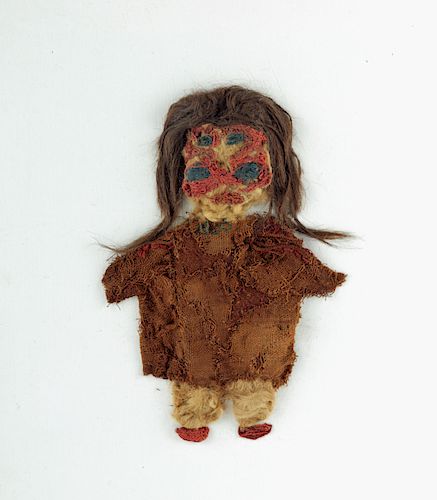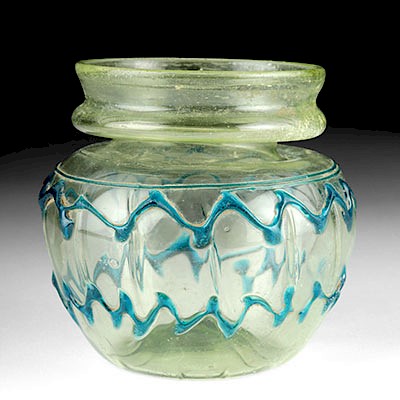Ancient Paracas Textile Child's Doll - Extremely Rare!
Lot 120
About Seller
Artemis Fine Arts
686 S Taylor Ave, Ste 106
Louisville, CO 80027
United States
Selling antiquities, ancient and ethnographic art online since 1993, Artemis Gallery specializes in Classical Antiquities (Egyptian, Greek, Roman, Near Eastern), Asian, Pre-Columbian, African / Tribal / Oceanographic art. Our extensive inventory includes pottery, stone, metal, wood, glass and textil...Read more
Estimate:
$1,900 - $2,850
Absentee vs Live bid
Two ways to bid:
- Leave a max absentee bid and the platform will bid on your behalf up to your maximum bid during the live auction.
- Bid live during the auction and your bids will be submitted real-time to the auctioneer.
Bid Increments
| Price | Bid Increment |
|---|---|
| $0 | $25 |
| $300 | $50 |
| $1,000 | $100 |
| $2,000 | $250 |
| $5,000 | $500 |
| $10,000 | $1,000 |
| $20,000 | $2,500 |
| $50,000 | $5,000 |
| $100,000 | $10,000 |
| $200,000 | $20,000 |
About Auction
By Artemis Fine Arts
Aug 16, 2018
Set Reminder
2018-08-16 10:00:00
2018-08-16 10:00:00
America/New_York
Bidsquare
Bidsquare : Clearance Sale - Ancient / Ethnographic Art
https://www.bidsquare.com/auctions/artemis-gallery/clearance-sale---ancient-ethnographic-art-3368
These lots are going, going, gone... plus a nice selection of lots brand-new to auction! Artemis Fine Arts info@artemisfinearts.com
These lots are going, going, gone... plus a nice selection of lots brand-new to auction! Artemis Fine Arts info@artemisfinearts.com
- Lot Description
**Originally Listed At $1000**
Pre-Columbian, South Coast Peru, Paracas culture, ca. 500 to 300 BCE. A fabulous hand-built doll comprised of tightly-woven camelid (alpaca or llama wool) fibers as well as human hair in hues of scarlet, cobalt, caramel, wheat, and coffee. The doll is comprised of a rough tunic with two sleeves, a pair of delineated legs with red shoes, a circular head with blue eyes and a red mouth, red facial threads, and a flowing hairdo of coarse brown hair with a tinge of red. This doll may have been part of a larger figure or perhaps sewn onto a larger textile swath with several other figures. Very few examples of Paracas dolls still exist, so this example is one of extreme rarity. Mounted on a fabric-lined wooden frame. Size (doll): 6" W x 8.75" H (15.2 cm x 22.2 cm); size (frame): 12.875" W x 15" H (32.7 cm x 38.1 cm).
Little is known about the Paracas people, and what little we do know comes from a 1920s archaeological excavation of the Paracas Cavernas, shaft tombs containing multiple burials, many of which contained ceramic vessels, probably for holding offerings or provisioning the dead in the afterlife. The iconography of the Paracas people is linear and stylistic, based on formal figures whose species, when zoomorphic, often cannot be identified. Motifs on their textiles mirror those of their ceramics that they used to wrap their dead and probably represent gods or mythical figures of power.
Dolls like this may not have been so simplistic as children needed protection as well. Dolls were not only a means of keeping a playful child occupied, but as a symbolic means of protection against evil spirits or natural forces that may cause harm to a child. Archaeologists have ample evidence of child-oriented play things in Pre-Columbian South America, like with the Chimu or the Chancay, though very seldom do they find dolls, toys, or evidence that such objects existed within the Paracas culture. The archaeological community does not understand the purpose of such Paracas dolls, though examples such as this may provide some insight into their underlying purpose.
Provenance: private Hawaii, USA collection; ex-private H. J. Westermann collection, Germany
All items legal to buy/sell under U.S. Statute covering cultural patrimony Code 2600, CHAPTER 14, and are guaranteed to be as described or your money back.
A Certificate of Authenticity will accompany all winning bids.
We ship worldwide and handle all shipping in-house for your convenience.
#136596Minor fraying to interior and peripheral threads, light fading to thread coloration, and some minor staining.Condition
- Shipping Info
-
All shipping is handled in-house for your convenience. Your invoice from Artemis Gallery will include shipping calculation instructions. If in doubt, please inquire BEFORE bidding for estimated shipping costs for individual items.
-
- Buyer's Premium



 EUR
EUR CAD
CAD AUD
AUD GBP
GBP MXN
MXN HKD
HKD CNY
CNY MYR
MYR SEK
SEK SGD
SGD CHF
CHF THB
THB














